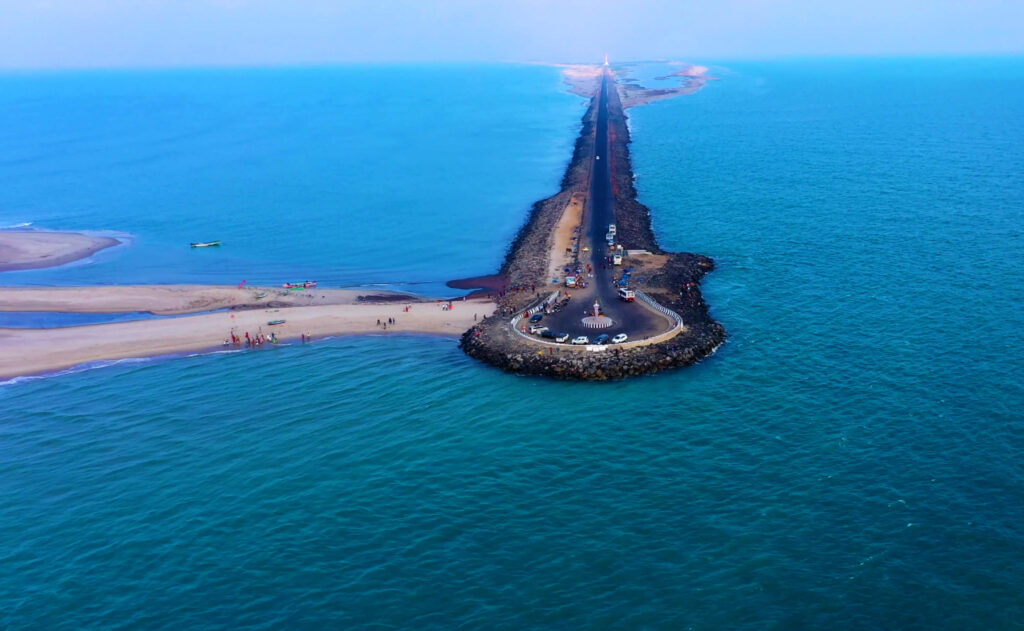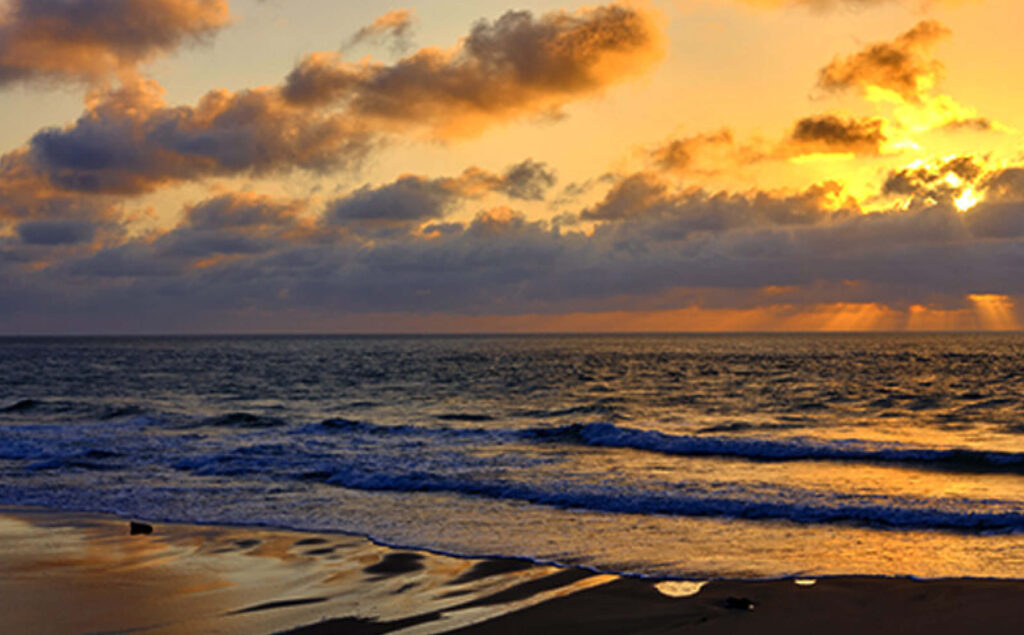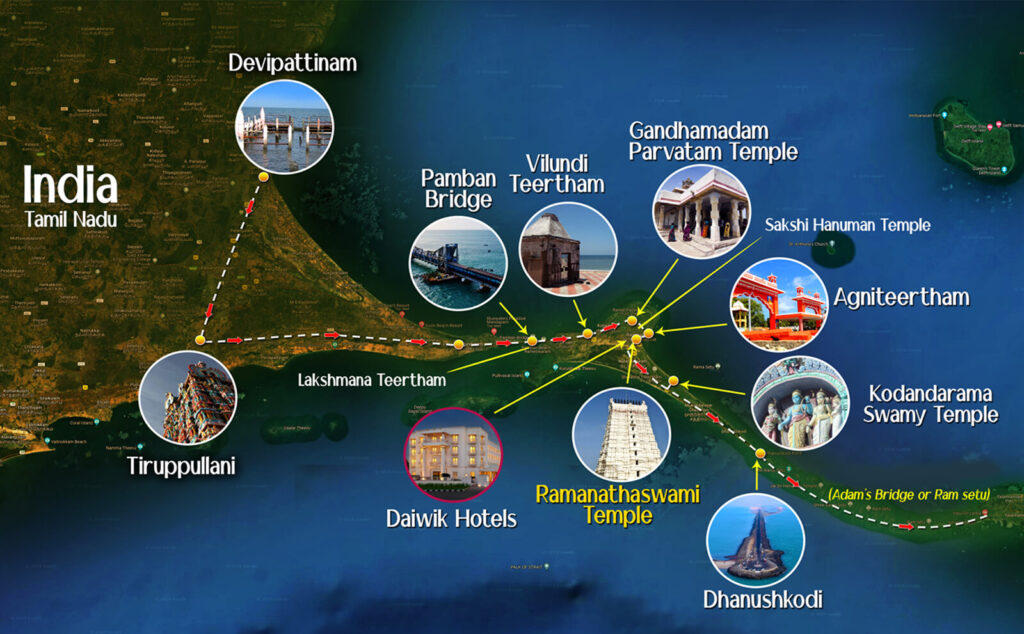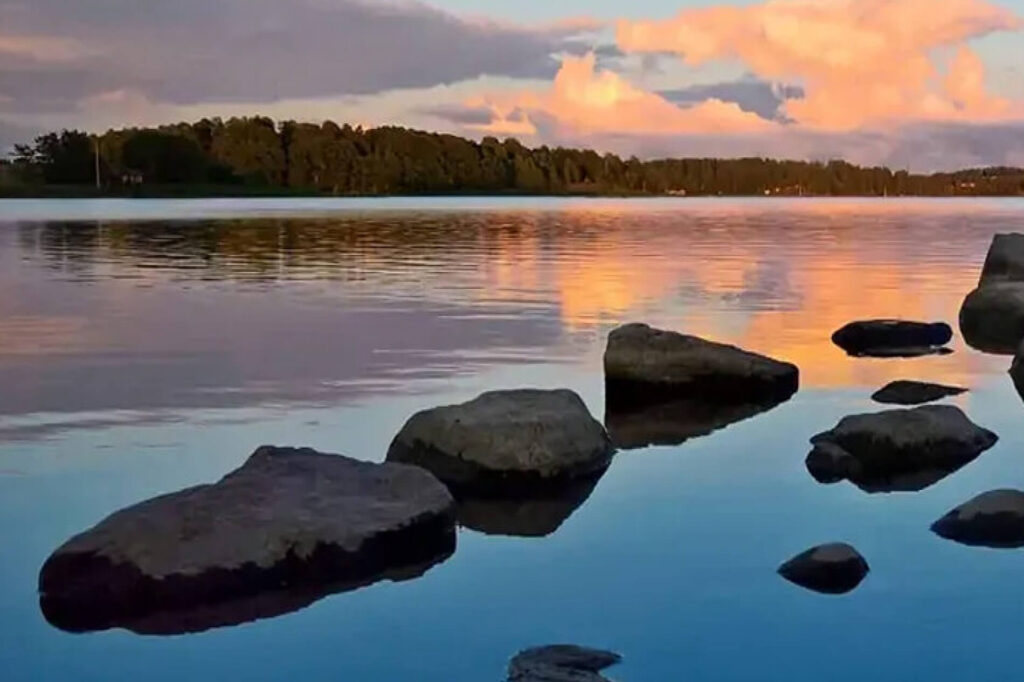Rameswaram is renowned as one of the holiest pilgrimage destinations in India. It is home to the iconic Ramanathaswamy Temple, dedicated to Lord Shiva. The temple is believed to be one of the twelve Jyotirlinga shrines, making it a significant site for Hindu devotees. The town is also associated with the epic Ramayana, with many sites linked to Lord Rama’s journey to rescue his wife Sita from the demon king Ravana.
According to the Ramayana, Lord Rama, alongwith his army of Vanaras (monkey warriors), built a bridge called “Setu” from Rameswaram to Lanka (modern-day Sri Lanka) with the help of Lord Hanuman and his devotees. This bridge is famously known as “Rama Setu” or “Adam’s Bridge.”
In The Footstep of Lord Rama
1. NAVAGRAHA TEMPLE, DEVIPATTINAM
Lord Rama worshipped the Goddess Durga and the nine planets here, praying for victory in the battle against Ravana. Lord Rama placed nine stones upright in the shallow bay and worshipped them, hence the name of the site – Navabashanam, the nine sacred stones.
It has a templededicated to Devi who is said to have killed the demon Mahishasura at this spot. It is said that Rama calmed the sea at this coastal village to install nine stones representing the Navagrahas. These stones can still be seen partly submerged in the water close to the beach near a bathing place of the Thilakeshwar Temple or the Navagraha Temple.Hindusperform religious rites for their forefathers here.
2. DARBHASHAYANAM TEMPLE THIRUPULLANI
Here Lord Rama meditated, lying on a bed of grass praying to Lord Varuna, God of the Oceans, requesting the sea to move away. When Varuna refused, an angry Rama picked up his bow swearing he would dry up the waters, at which Varuna promised to support the bridge built by VanarSena- the monkey army. Rama also worshipped Vishnu at the AdiJaganatha temple here who presented Rama with a celestial bow called Divyasarabham.
Rama returned here with Sita after his coronation to perform a yagna. Now there is a shrine called Pattabhishekaharama in the temple precincts to commemorate the occasion.
3. VILLOONDI THEERTHAM THANGACHIMADAM
After coming back from Lanka, one day when Sita was thirsty, Rama created a sweet water spring here by aiming an arrow. The well is located in the sea and still contains sweet water. It is considered to be a sacred place.
4. GANDHAMADANA PARVATHAM TEMPLE, RAMESWARAM
Legend mentions that Hanuman leaped from this hillock to reach the Lanka kingdom. The double storied Mandapam has the imprinted footprints of Lord Rama on the Chakra. The hillock is thronged by devotees of Lord Rama. The temple is the also called Ram Jharokha.
5. SAKSHI HANUMAN MANDIR
This is where Hanuman gave Lord Rama, the ring that Sita had given him in the Ashok Vatika, Lanka.
6. KODANDARAMA TEMPLE, RAMESWARAM
Here, Vibhishana, Ravana’s brother joined hands with Rama. Later, he was crowned the king of Lanka here and hence Vibhishana too is worshipped at the temple.
7. DHANUSHKODI, RAMESWARAM
This is the site of a sacred confluence of waters as the Indian Ocean and the Bay of Bengal, and it is also the site of the Ramsethu or the final bridge to Lanka.
Hindu scriptures mention that on the request of Vibhishana, brother of Ravana, Rama broke the Sethu with one end of his bow and hence the name Dhanushkodi, Dhanush meaning bow and Kodi stands for end. A series of rocks and islets found in a line are remnants of the ancient Sethu also known as Rama’s Bridge.
8. AGNITHEERTHAM
Rama took a bath here before the yagna to worship Lord Shiva. Pilgrims bathe in this beach to purify themselves before heading for the Ramanathaswamy Temple.
9. RAMANATHASWAMY TEMPLE
The Ramanathaswamy Temple is the main shrine of Rameswaram. It is one of the greatest temples in India.
The story of the temple dates back to the time when the war in Lanka was over and Rama decided to perform a yagna for Lord Shiva. The temple stands on the site of the antyeshti and prayaschittyayagnas of Rama.
The SkandaPurana says for the yagna Rama needed a shiva lingam and sent Hanuman to Mount Kailash to fetch a crystal lingam. However, Hanuman failed to return by the auspicious hour and therefore Sita created a lingam with sand. This is the Ramanatha lingam and Shiva was worshipped as Ramanatha, Lord of Rama.
When Hanuman came back he was deeply disappointed. So Rama decreed that both thelingams would be installed together. Hanuman’s lingam was named Vishwa lingam, and Rama decreed that the Vishwa lingam will always be worshipped first.
Today the majestic Ramanathaswamy Temple with two lingams in the garbhagriha, stands at the site of this yagna. The temple has two more lingams, one of which is behind the 16ft tall statue of Hanuman. The present temple was built three centuries ago and is considered one of the finest examples of Dravidian architecture. It has the longest temple corridor in India with 1,212 pillars carved with exquisite images. There are 22 holy Teerthams or tanks/wells within the temple precincts where pilgrims bathe before their offerings.
















